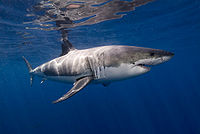Difference between revisions of "Great white shark"
DavidB4-bot (Talk | contribs) (→top: Spelling/Grammar Check, typos fixed: world-wide → worldwide) |
DavidB4-bot (Talk | contribs) m (→Attacks on humans: HTTP --> HTTPS [#1], replaced: http://en.wikipedia.org → https://en.wikipedia.org) |
||
| Line 52: | Line 52: | ||
Most attacks on surfers and swimmers are believed to cases of mistaken identity, and they are generally not finished off, their [[flavor]] comparing poorly with that of a [[blubber]]y [[pinnipedia|pinniped]]. | Most attacks on surfers and swimmers are believed to cases of mistaken identity, and they are generally not finished off, their [[flavor]] comparing poorly with that of a [[blubber]]y [[pinnipedia|pinniped]]. | ||
| − | The book and film ''[[Jaws]]'' is based on the inaccurate theory of a "rogue shark," a theory that is widely considered to be inaccurate.<ref> | + | The book and film ''[[Jaws]]'' is based on the inaccurate theory of a "rogue shark," a theory that is widely considered to be inaccurate.<ref>https://en.wikipedia.org/wiki/1992_Cageless_shark-diving_expedition</ref> |
Great white sharks have recently become rare due to human persecution, and are now protected in [[South Africa]] and [[Australia]]. | Great white sharks have recently become rare due to human persecution, and are now protected in [[South Africa]] and [[Australia]]. | ||
Latest revision as of 17:06, September 26, 2018
| Great White Shark | |
|---|---|

| |
| Scientific classification | |
| Kingdom Information | |
| Domain | Eukaryota |
| Kingdom | Animalia |
| Subkingdom | Bilateria |
| Phylum Information | |
| Phylum | Chordata |
| Sub-phylum | Vertebrata |
| Infraphylum | Gnathostomata |
| Class Information | |
| Class | Chondrichthyes |
| Sub-class | Elasmobranchii |
| Infra-class | Euselachii |
| Order Information | |
| Order | Lamniformes |
| Family Information | |
| Family | Lamnidae |
| Genus Information | |
| Genus | Carcharodon |
| Species Information | |
| Species | C. carcharias |
| Population statistics | |
| Population | Unknown |
| Conservation status | Vulnerable[1] |
The great white shark (Carcharodon carcharias) is a species of shark in the order Lamniformes, and the only member of the genus Carcharodon. Known variously around the world as "white pointer", "white death" (Australia), "blue pointer" (South Africa), and "man-eater" (worldwide), the white shark has brought extensive scientific and media attention to investigate its habits and behavior.
Description
The white shark is the third-largest fish on record, exceeded in size only by the plankton-feeding whale and basking sharks. It is a large-bodied, robust animal with an average length between 13–15 feet, and weigh between 1,500-2,450 pounds.[2] Larger individuals have been caught from time to time,[3] with 21 feet the largest length currently recorded for two individual, one caught in Cuba in the 1940s, and one caught off the Azores in 1978.
The white shark has a coloration pattern shared by the orca and penguins in that it is generally a dark grey above, and a pale cream to white underside, thought by scientists to be a camouflage pattern. Its large crescent tail provides quick bursts of speed when needed.
Habits
Great white sharks are found worldwide in tropical and temperate waters. They can regulate their body temperature to some degree, so as to remain active in cold water. Feeding particularly on marine mammals such as fur seals and sea lions, great white sharks typically capture their prey by giving a single devastating bite, then retreating and circling until the victim has bled to death.
Attacks on humans
Most attacks on surfers and swimmers are believed to cases of mistaken identity, and they are generally not finished off, their flavor comparing poorly with that of a blubbery pinniped. The book and film Jaws is based on the inaccurate theory of a "rogue shark," a theory that is widely considered to be inaccurate.[4]
Great white sharks have recently become rare due to human persecution, and are now protected in South Africa and Australia.
References
- ↑ http://www.iucnredlist.org/apps/redlist/details/3855/0/full
- ↑ http://www.jawshark.com/great_white_recorded_sizes.html
- ↑ http://news.nationalgeographic.com/news/2011/05/110506-biggest-great-white-sharks-apache-caught-animals-science/
- ↑ https://en.wikipedia.org/wiki/1992_Cageless_shark-diving_expedition